High-Level Hijinks
We’ve had a lot of low-level spells floating around Obscure Arcana lately, with entire articles of nothing but 1st- and 2nd-level spells. While it’s all well and good to try to make sure that low-level characters have plenty of toys to play with, it’s also important to make sure that there are some worthwhile spells at the deeper end of the pool to make acquiring higher-level magic more rewarding. So, naturally, I decided to do an entire article of nothing but 9th-level spells.
Of course, “a bunch of 9th-level spells” is hardly a theme to bring an article together, and we generally try to have at least a thin façade of method to our madness. As a result, there is a second theme to this week’s article. But I’m not going to say what it is. That wouldn’t be fun. Instead, I’m going to let you try and guess it, and the first three people who send the correct answer to ariggs@necromancers-online.com will win a free pdf of any Necromancers of the Northwest product that they want.
Of course, the real reason you’re here is to check out some big, splashy spells, so why don’t we get down to business?
Defiant Blast
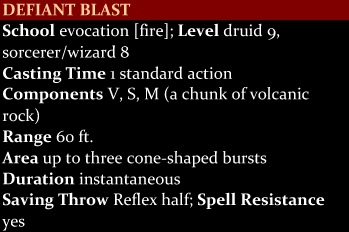
Roaring fire explodes from your hands and mouth, and three cones of white-hot flame spiral outward from your body. These three cones can be arranged in whatever pattern you like, but they must all originate from your square. Each creature in an affected area suffers 1d6 points of fire damage per caster level you possess, to a maximum of 15d6 points of damage. Creatures that are within the area of more than one cone created by this spell do not take additional damage, but instead suffer a -2 penalty on their saving throw.
Ectoplasmic Realization
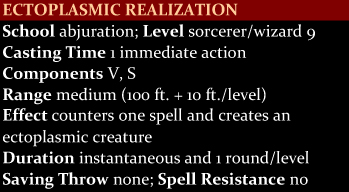
You take control of the energy used to power a spell as it is being cast, hijacking it and forcing it to instead manifest in the form of a creature made of ectoplasmic ooze. In order to cast ectoplasmic realization, a creature within the spell’s range must be casting a spell. If no spell is being cast within the spell’s range at the time that ectoplasmic realization is cast, then ectoplasmic realization has no effect. If there are multiple spells being cast simultaneously, you may choose which spell to affect with ectoplasmic realization.
Make a caster level check (DC 11 + the caster level of the spell to be affected). If you do not successfully identify the spell to be affected via a Spellcraft check or other means, you suffer a -5 penalty on this check. If you fail the caster level check, ectoplasmic realization has no effect. If you succeed on the caster level check, however, the targeted spell has no effect, as though you had successfully countered the spell. Additionally, ectoplasmic realization creates a creature made of pure ectoplasm in an unoccupied square within range.
The ectoplasmic creatures created by this spell can take a variety of forms. You may choose to have the ectoplasmic creature manifest in the form of any creature whose CR is no greater than 3 plus the spell level of the spell that was countered. The ectoplasmic creature’s statistics are identical to a normal creature of the chosen type, except that it has no Intelligence score, gains the mindless special quality, and is immune to critical hits or precision-based damage. The ectoplasmic creature obeys your commands and functions in all ways as though summoned by summon monster I for one round per caster level you possess. At the end of this time, or as soon as it is reduced to 0 hit points, the ectoplasmic creature crumbles into dust, which fades into nothingness one round later.
Fury of the Fiery Heavens
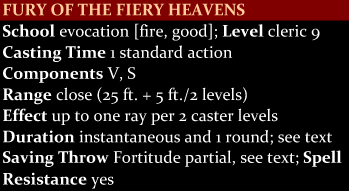
You stretch forth your hand, and from your fingertips fly several brilliant ruby-red arrows, which fly through the air towards your foes. Each ray deals 5d6 points of fire damage. A ray that hits an evil-aligned creature deals an additional 3d6 points of non-typed damage to that creature. Additionally, each non-good creature that is hit by one of these rays must succeed on a Fortitude save or be dazed for 1 round. Evil creatures suffer a -4 penalty on this saving throw.
You may not target any given creature with more than one ray. If there are more rays than there are targets within range, any additional rays are wasted.
Heartless Banishment
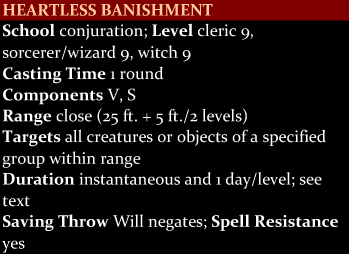
You give a description of a certain type of object or creature, and everything matching your description within the spell’s range vanishes from this plane of existence. When you cast heartless banishment, you must give a brief description (10 words or less) of a creature or object. The description can be as vague or specific as you like, but is limited entirely by the words you use, and must be an objective description, not a subjective one (you could, for example, specify “goblins,” “plants,” “living creatures,” “objects made of metal,” “royalty,” “people with brown hair and blue eyes,” or “people named Raxen Dale,” but not “that guy over there” or “him,” or even “enemies.”).
All creatures or objects within the spell’s range that match the description you choose are immediately affected as though by the spell plane shift, except that the plane that they arrive on is determined randomly (all creatures affected by a given instance of heartless banishment are sent to the same randomly-determined plane, however). Creatures that would be affected by the spell can negate the effects with a successful Will save, as can attended objects and magical objects. Unattended, non-magical objects are not allowed a saving throw to resist the spell’s effect.
Creatures and objects affected by this spell cannot return to the plane that they were banished from by any means until a number of days equal to your caster level have passed. If such characters attempt to return before that time, any attempt to do so (whether via plane shift, gate, or other means) simply fails.
Maddening Magic
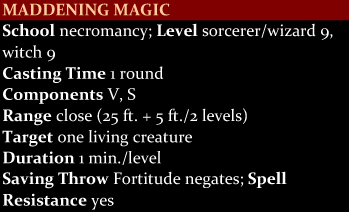
Almost universally banned in mage duels, this spell plants a seed of corruption in the target’s own magic, causing his mind to twist and warp the more he casts spells. For the spell’s duration, whenever the target casts a spell, he loses one of his highest-level prepared spells or unused spell slots. If the target does not have a prepared spell or unused spell slot of the highest level that he can cast remaining, he instead loses a prepared spell or unused spell slot of the next-highest level that he does have, and takes an amount of Intelligence, Wisdom, and Charisma damage equal to the difference in level between the highest-level spell he can cast and the spell level of the prepared spell or spell slot that he actually loses (for example, Raxen Dale, a 17th-level wizard, is affected by this spell. If he attempts to cast a spell, he will lose one 9th-level spell he has prepared, in addition to the spell that he casts. If he does not have any more 9th-level spells prepared, he instead loses an 8th-level spell and takes 1 point of Intelligence, Wisdom, and Charisma damage. If he did not have any more 8th-level spells prepared, he would instead lose a 7th-level spell and take 2 points of Intelligence, Wisdom, and Charisma damage, and so on). Any ability damage that the target suffers as a result of this spell does not change the highest-level spell that he is capable of casting for the purposes of determining how much ability damage he will take if he continues casting spells.
Any ability damage inflicted by this spell persists after the spell’s duration ends, and can be cured normally.
All right, there you go. Have you figured out what the theme is yet? No? All right, well, I’ll give you two hints (after all, there are already five hints, above).
Hint #1: We’ve done articles with very similar themes in the past, one in Obscure Arcana, and several in older columns like Dark Designs and Foursaken Feature.
Hint #2: This article was written very shortly after the weekend of January 26th and January 27th.
Hopefully you’ve got it, now. If you do, send an e-mail to ariggs@necromancers-online.com with your answer, and be sure to include the name of the Necromancers of the Northwest book you’d like a free digital copy of. If you’re one of the first three with the correct answer, it will be yours.


